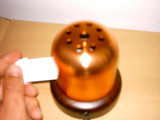Fine cloth aromatherapy diffuser
Pour 3 to 4 drops of essential oil in a fine cloth and put the cloth next to you. With the movement around the room, (of yourself, other people or things) you will notice the aroma.
- Advantage: you can perform this technique anywhere.
- Disadvantage: Does not release too much smell around the room.
Heat aromatherapy diffuser
- Advantage: Spread the aroma easily across the room.
- Disadvantage: It is not long-lasting. Heat may actually alter or destroy some components of oils, so healing properties swill not be the best as with cold air.
Aromatherapy candle diffuser
Remember: Essential oils are inflammable, so try not to put more than 1 drop.
- Advantage: you can use it in any candle-safe area.
- Disadvantage: Extreme care with candles. Aroma does not last long. Heat can alter or destroy essential oils components.

